Table of Contents[Hide][Show]
A nourishing homemade baby formula using safe, whole ingredients. This recipe was developed and tested by Dr. Mary Enig, a PhD Nutritionist and originally published in Nourishing Traditions cookbook in 1996. It was formulated to match breastmilk as closely as possible and is also suitable for infants. Source: Weston A. Price Foundation
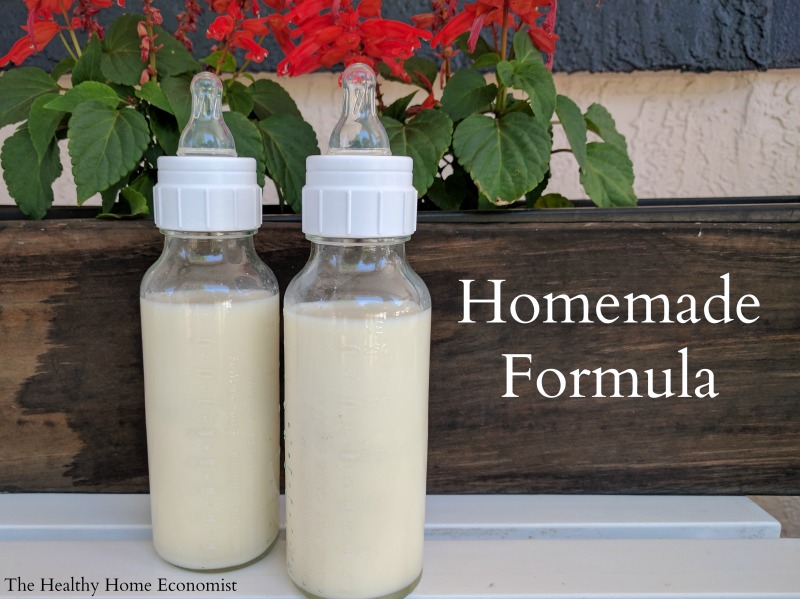
There is no doubt that breastfeeding your baby is the best option for the child’s long-term health and development. Human breastmilk from a well-nourished mother is the perfect food for baby. However, in circumstances where the child is adopted or the Mother finds herself unable to breastfeed, formula feeding becomes necessary. In those cases, homemade baby formula is best.
Using a baby formula recipe that closely matches the nutritional profile of breastmilk is a far better choice than even organic baby formula from the health food store. More on this below.
Note: Donor programs are widely available for human breastmilk. But, the diets of the donor mothers are unknown and most likely nutritionally insufficient. In addition, breastmilk banks pasteurize the donated breastmilk which destroys much of the nutritional benefit. Unless you are fortunate to have a trusted and direct donor milk source in your community, avoid this option!
Dangers of Commercial Formula
Commercial formulas are always a poor choice for a number of reasons. First of all, formula manufacturers line the cans with the chemical BPA. This substance disrupts hormone development and is a probable contributor to early puberty in girls, and ADHD, urogenital abnormalities, and other ills in boys.
The European Food Safety Authority found that canned commercial formula is a significant source of BPA for infants, exposing the child to 13mcg of BPA per kg of body weight per day! BPA-free formula cans are no better. The chemical BPS is typically used instead which is just as dangerous.
Beware that manufacturers pack even organic commercial formula like Earth’s Best in BPA cans. Worse, they use organic brown rice syrup as the primary sweetener which is known to be frequently contaminated with arsenic.
In addition, all commercial milk formulas are processed at extremely high temperatures which violently denature the fragile milk proteins, render them allergenic, and add carcinogens to the final product. Soy infant formula is the worst. Obscenely high processing temperatures not only denature the proteins but large levels of phytic acid in soy block mineral absorption by the infant. Moreover, soy-based plant estrogens disrupt the hormonal development of the baby!
It seems that for the concerned Mother who is unable to breastfeed, learning how to make baby formula at home with safe, pure ingredients is the most prudent way to go!
Why Make Homemade Formula Even if You Are Breastfeeding
In the video below, I show you how to make your own safe, healthy raw milk homemade formula for your baby.
The recipe I follow was originally published in the cookbook Nourishing Traditions in 1996 and developed by Dr. Mary Enig.
Even though I breastfed each of my children for at least 2 years, I made this exact formula for my own children when I was away for the day or the evening as pumping was not an option that worked well for me.
I even used this homemade formula for an entire day once when I had some dental work done and was advised to pump and discard for 24 hours.
As a result, even successfully breastfeeding Moms can use this wonderful homemade formula as a supplement when necessary to their own nutrient-dense breastmilk!
It is advised that even breastfeeding Mothers have the ingredients for this formula on hand for an emergency. If Mom is sick or otherwise unable to nurse, Dad can step in and make this safe alternative until Mom is back on her feet. It takes a few days to a week to gather all the ingredients together to make this formula, which is why I advise having them on hand at all times.
Homemade Most Nutritious
The image below lists the reasons why it is worth it nutritionally to make formula yourself for your precious baby!
You can order all of the required ingredients for the homemade baby formula in one package from this reputable, vetted source.
Moms who have successfully used this formula feeding your children, please post about your experience in the comments section to encourage those who are considering it and need some Mom to Mom encouragement!
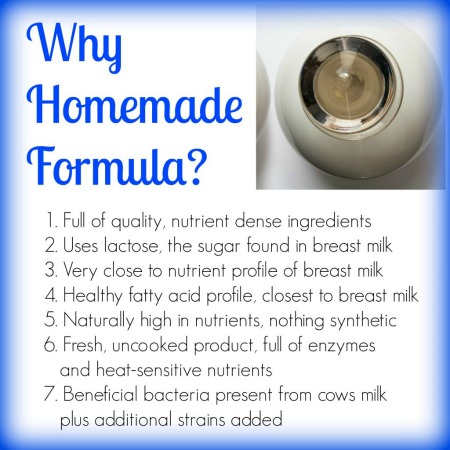
Where to Source Quality Milk
The most widely available grass-fed milk around the world is from cows. This is usually the most budget-friendly and easily sourced milk for this recipe for homemade formula.
If only goat milk is available in your area, this recipe for goat milk baby formula can be used instead. When using milk from ewes, please refer to the linked article for an adjusted recipe; one of the benefits of sheep milk is that it is higher in healthy fats than either goat or cow milk.
Camel milk formula is another option that is a particularly digestible form of dairy and growing in popularity around the world.
Alternatively, you can use low temp (vat) pasteurized, non-homogenized whole milk cultured with a piima or kefir starter. Then substitute the piima milk or kefir for the raw milk portion of the formula recipe. Cold-pressed raw milk also must be cultured before using it as it contains no probiotics.
Do NOT use ultrapasteurized (UHT) milk even if organic as it is too highly processed and extremely allergenic!
It is also best to avoid all types of powdered milk for this recipe. The factory process of making milk powder reduces nutrition considerably and denatures it, which makes it more likely baby will have an allergic reaction.
Dairy Allergy Option
If all types of dairy prove unsuitable for your baby, make this nondairy baby formula recipe instead. It uses a base of homemade bone broth as a substitute for milk. It is important not to utilize a plant-based or otherwise vegan baby formula recipe.
Avoid buying bone broth to make the dairy-free formula. Make it yourself! Manufacturers of commercial bone broth, even if authentic, may water down the end product. This is apparent if it does not gel when chilled in the refrigerator.
Many brands have toxic packaging issues as well. If you must buy it in a pinch, see my shopping guide page for vetted brands that are safe.
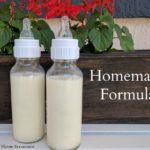
Homemade Baby Formula Recipe (for infants too)
A nourishing baby formula recipe you can make at home with safe, whole ingredients developed and tested by a PhD nutritionist to match breastmilk as closely as possible. Also suitable for infants.
Ingredients
- 2 cups raw cow milk OR organic whole milk yogurt
- 1 7/8 cups filtered water
- 1/4 cup liquid whey
- 4 Tbl lactose
- 1/4 tsp Bifidobacterium infantis powder
- 2-4 Tbl raw or pasteurized cream
- 1/2 tsp cod liver oil unflavored
- 1/4 tsp butter oil unflavored
- 1 tsp sunflower oil preferably organic
- 1 tsp extra virgin olive oil preferably organic
- 2 tsp virgin coconut oil preferably organic
- 2 tsp nutritional yeast
- 2 tsp gelatin
- 1/4 tsp acerola powder
Instructions
-
Fill a 2 cup Pyrex measuring cup with filtered water and remove 2 TBL (this will give you 1 7/8 cup water).
-
Pour about half the water into a pan and turn burner on medium.
-
Add the gelatin and lactose and let dissolve, stirring occasionally.
-
When gelatin and lactose are dissolved, remove pan from heat and add the rest of the water to cool.
-
Stir in the coconut oil and butter oil until melted.
-
Put remaining ingredients in a glass blender.
-
Add the water mixture and blend for about 3 seconds.
-
Place formula in glass baby bottles or a glass jar and refrigerate.
-
Before giving to baby, warm glass bottle in a pan of hot water or a bottle warmer. NEVER microwave baby bottles!
Recipe Video
Recipe Notes
If using raw cow milk from holstein cows, use 4 Tbl of extra cream (otherwise use 2 Tbl extra cream).
If choosing to make this homemade formula with camel milk, be sure to include 4 Tbl extra cream as camel milk is lower in cream than cow milk.
Do not use high oleic sunflower oil. Use only the brand recommended in the ingredients list which is cold pressed, organic, unrefined, and low oleic.
*Do NOT use powdered whey from the store as it is denatured. Avoid whey from making cheese as it will curdle the formula.
*Do not substitute pasteurized or powdered milk as these are heavily processed, denatured and allergenic foods.
*Do NOT use ultrapasteurized (UHT) cream. It is highly allergenic. Raw or pasteurized cream is acceptable.
*Do NOT use fish oil or krill oil instead of high vitamin cod liver oil as they do not contain any Vitamin D and very little to no Vitamin A.
Collagen powder may be substituted for the gelatin in a pinch (more on peptides in baby formula in this article).
If you are wondering where is the iron in homemade baby formula, this article provides an explanation.
If baby experiences constipation using this formula, try adding 1 tsp of molasses to each batch. This should help move things along.
How to Transition to DIY Formula
Once you’ve viewed the video, gathered the ingredients, and made your first batch, how do you feed it to your baby for the first time?
It is important not to switch all at once as this can cause gas, excessive spit-up, or an uncomfortable change in diaper habits such as constipation or overly loose stools.
Start by giving your baby three-quarters of the old formula blended with one-quarter of the homemade. Try this ratio for a day or two and see how your infant responds.
If no digestive upset or major change in diaper habits occurs, increase the amount to a 50-50 blend of old formula to homemade. Observe for another day or two as before.
If no major issues, increase once again to three-quarters homemade formula to one-quarter old formula. If baby does well on this blend for a third time, you are ready to fully transition to the homemade formula.
At any time during the transition, symptoms of intolerance emerge, back up to the previous successful blend ratio and stay there for a day or two before attempting to increase once again.
Homemade Formula FAQ
Weston Price Foundation
Feeding an Adopted Baby
Traveling Tips with Baby Formula Made at Home
Iron in Baby Formula
Collagen Peptides instead of Gelatin for Homemade Formula?


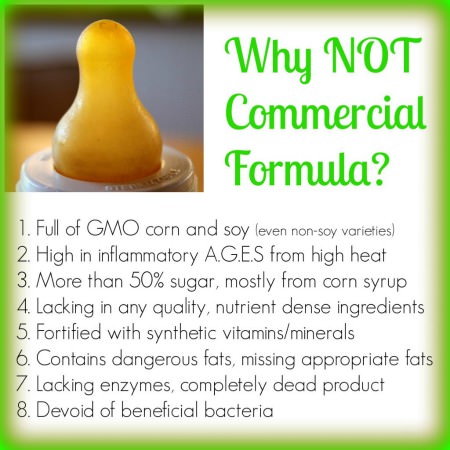
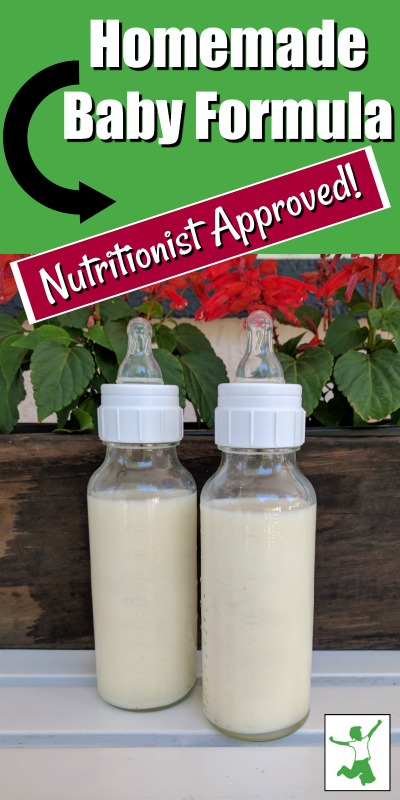






Hi Sara, I got the response below from a fellow mother and doula when I listed the WAPF homemade formula as an option for a mom looking for options as she needs to ween early and there is a dairy allergy. “Homemade formula recipes are completely unregulated and often unsafe, especially those created by companies intending to sell the products they recommend. Infants can and have suffered severe electrolyte imbalances, vitamin deficiencies and overdoses, dehydration, and severe GI injury from homemade formula. In particular, recipes including liver are generally extremely high in vitamin A, often to toxic levels. Human breastmilk is an amazing, unique substance, which requires a LOT of complex scientific work to imitate safely and successfully.”
I’m looking to find any articles/info. on babies having imbalances due to strict homemade formula use and so far haven’t found any. Do you know of any? While I understand many people needing caution (as there are some that would alter the recipes or not be meticulous with making the recipe and missing steps or substituting ingredients.) I see how that could be problematic and dangerous, but otherwise, I trust homemade. What would you say to someone making the comments above? Thanks!
The WAP formula was developed by Dr. Mary Enig to closely match breastmilk as much as possible. This recipe was developed LONG BEFORE Radiant Life sponsored the annual Wise Traditions conference as a vendor. Radiant Life simply packages up the recommended ingredients into a convenient package which is shipped to parents interested in making the formula. That’s it. The WAPF doesn’t make any money off of that. Not sure what beef anyone could have with that, quite honestly.
The vitamin A in the WAP formula is natural A … not synthetic A which is what is toxic. Natural A at the levels in the homemade formula has never been found to be toxic.
There are no cases that I am aware of where babies using this formula suffered from imbalances or were otherwise improperly nourished.
My twins have been on the WAP raw cow milk formula for about 3 weeks. They have been spitting it up and now it’s gotten worse and curdles and smells sour. I’ve never put the yeast in the formula but this last made up formula I left the gelatin out and they are still spitting up clear liquid and then it’s still coming up hour or so after with white cottage cheese looking spit up. What could be the problem?
You can do one of two things … try making the formula with plain, whole milk yogurt or kefir (homemade is best from raw milk) substituting either of these for the milk portion of the recipe. This will make the formula even more digestible and less likely the babies will spit it up.
Alternatively, you could also try the goat milk formula, camel milk formula, or sheep milk formula (links above in the article). These dairy milks are sometimes better tolerated by babies who might be sensitive to cow milk protein.
Hi Sarah,
I have been making this formula for a few weeks now. I will be traveling to my in-laws for Thanksgiving for a few days and wanted to know if I can freeze a couple of batches to take? Making it at their house really isn’t feasible, and honestly we want to avoid even telling them that it is homemade because of their judgement and the concern we know they will have about the raw milk factor. If freezing premixed formula is OK, does it matter what type of containers I use? I found freezer safe plastic, BPA free deli type “Reditainers” on Amazon. Or perhaps glass mason jars are better? Thanks!
Yes, absolutely! Make it and freeze individual portions in breastmilk bags and take in a small cooler is a good way to go.
My baby is 5 months old. My breast milk has come to a stop and I want to buy the kit to make my own formula. I didn’t really find raw milk close to my house but I found a local milk. “Mill king” from McGregor, TX. This a bit of their story.. “Craig and his wife, Rhianna, began producing raw milk with their cows after it was discovered that Rhianna’s allergy to milk did not react to raw milk.They along with Craig’s parents have expanded the business to include low-temperature pasteurized non-homogenized milk, cheese & cream.” … “Our milk is free of antibiotics, hormones, additives, and preservatives. It’s just milk. All natural and just the way nature intends”.
I am wondering would it be ok to use this milk and would it change the process of the recipe? since the recipe calls for raw milk.
If the milk isn’t raw, it cannot be used for this formula. Sounds like the milk you found is vat pasteurized (low temp pasteurized), cream top milk which still cannot be used.
You can legally ship raw camel milk to your home to make a very similar formula (recipe here:
OR you can find sheep yogurt at Whole Foods, Trader Joe’s etc and make this sheep milk formula.
Recipe here: https://www.thehealthyhomeeconomist.com/sheep-milk/
A third option is to make goat milk formula if you are able to find raw goat milk. If you can find plain, whole goat milk yogurt at the healthfood store, you can use that instead.
Recipe here: https://www.thehealthyhomeeconomist.com/goats-milk-formula/
My baby is 4 months old and I have been supplementing him with regular formula .can I supplement with your formula? .for how many days the formula will be good to drink?Can I get all these ingredients at whole foods market?also do you have any article talking about vaccines?
Best to switch off the regular store formula and use the homemade formula exclusively for supplementing. The formula is best made very day or every other day. A link to where to get the ingredients is included in the recipe. Yes … dozens of articles on vaccines on this blog if you use the searchbox at the top of the page.
can you make this in advance in store in the refrigerator and if so how long will it last?
This formula really needs to be made fresh every day or every other day. You can definitely freeze some on breastmilk freezer bags.
I’ve been making this recipe, but I pulled out my “Nourishing Traditions” book and noticed there were some variations. They suggested 1 tsp probiotic and 1 tsp cod liver oil, just wondering what the difference would be giving more of those?
Stick with the 1/4 tsp probiotic and 1/2 tsp high vitamin cod liver oil per batch as listed in the recipe above. Perhaps the 1 tsp of CLO that you saw was regular cod liver oil? The 1/2 tsp CLO is high vitamin CLO.
Perfect, that is what I was looking for, thanks! I am using the homemade formula just as written with raw milk. I just wasn’t sure if I still needed to supplement with additional vitamin D or not. I’m still trying to breastfeed as much as I can give my son, but since my supply is low he is probably getting 75% of the homemade formula now and 25% breast milk.
The only reason breastmilk is so low in Vitamin D is because the mothers are deficient! Be sure you are taking the cod liver oil too 🙂
Hi Sarah,
I have been making this formula for my 6 week old for about one week because my milk supply is low. The pediatrician told me to supplement 400 IU of vitamin D because breastmilk is lacking enough. Since my baby is primarily getting this formula now, should I still supplement with vitamin D? I know pasteurized milk is usually fortified with it. I just wasn’t sure if another ingredient in this formula had the necessary vitamin D needed. I just am afraid to overdose as I know that is possible. Thanks!
I am very confused. Are you breastfeeding or making the formula? I am reading your comment and am sincerely hoping you are NOT making this formula with pasteurized milk!!!! Especially the synthetically fortified Vitamin D supermarket milk!
If you make the homemade formula AS LISTED ABOVE, it contains plenty of vitamin D from the cod liver oil. There is no need to supplement with additional vitamin D.
My baby is 5 months old and is wanting to nurse every 2-3 hours around the clock. I would like to give him something more just before bed to fill him up a little so that he can skip at least one feed during the night. I am thinking 50/50 mixture of raw cows milk and water. What would you suggest?
A 50/50 mix of raw cow milk and water is not appropriate even for a single nighttime feed. If you want to supplement with the homemade formula, then make it ONLY as outlined in this post.
That said, there are ways to make your breastmilk richer and more satisfying so your baby goes longer between feeds. Eating more whole dairy, nuts, nut butters, cheese, meat, and especially EGGS will make a huge difference. In China, women are traditionally encouraged to eat up to a dozen eggs per day to make the BEST and RICHEST breastmilk.